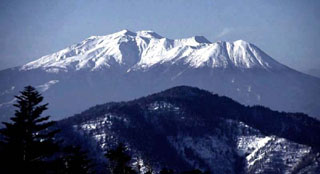Report on Ontakesan (Japan) — 23 February-1 March 2022
Smithsonian Institution / US Geological Survey
Weekly Volcanic Activity Report, 23 February-1 March 2022
Managing Editor: Sally Sennert.
Please cite this report as:
Global Volcanism Program, 2022. Report on Ontakesan (Japan) (Sennert, S, ed.). Weekly Volcanic Activity Report, 23 February-1 March 2022. Smithsonian Institution and US Geological Survey.
Ontakesan
Japan
35.893°N, 137.48°E; summit elev. 3067 m
All times are local (unless otherwise noted)
JMA reported that the number of volcanic earthquakes at Ontakesan began increasing at 1415 on 23 February. Four minutes later a volcanic tremor signal was detected along with uplift on the S flank. At 1635 JMA raised the Alert Level to 2 (on a scale of 1-5). The report warned the public to stay at least 1 km away from Crater 79-7 on the SW flank of the Kenga-mine summit. After a peak on 25 February, the number of daily volcanic earthquakes began to decline; there were two volcanic earthquakes recorded on 24 February, a total of 17 on 25 February, 4-5 per day during 26-28 February, and 3 on 1 March. During an overflight on 25 February scientists observed no changes in the fumarolic areas or other morphological changes on the volcano.
Geological Summary. The massive Ontakesan stratovolcano, the second highest volcano in Japan, lies at the southern end of the Northern Japan Alps. Ascending this volcano is one of the major objects of religious pilgrimage in central Japan. It is constructed within a largely buried 4 x 5 km caldera and occupies the southern end of the Norikura volcanic zone, which extends northward to Yakedake volcano. The older volcanic complex consisted of at least four major stratovolcanoes constructed from about 680,000 to about 420,000 years ago, after which Ontakesan was inactive for more than 300,000 years. The broad, elongated summit of the younger edifice is cut by a series of small explosion craters along a NNE-trending line. Several phreatic eruptions post-date the roughly 7300-year-old Akahoya tephra from Kikai caldera. The first historical eruption took place in 1979 from fissures near the summit. A non-eruptive landslide in 1984 produced a debris avalanche and lahar that swept down valleys south and east of the volcano. Very minor phreatic activity caused a dusting of ash near the summit in 1991 and 2007. A significant phreatic explosion in September 2014, when a large number of hikers were at or near the summit, resulted in many fatalities.

